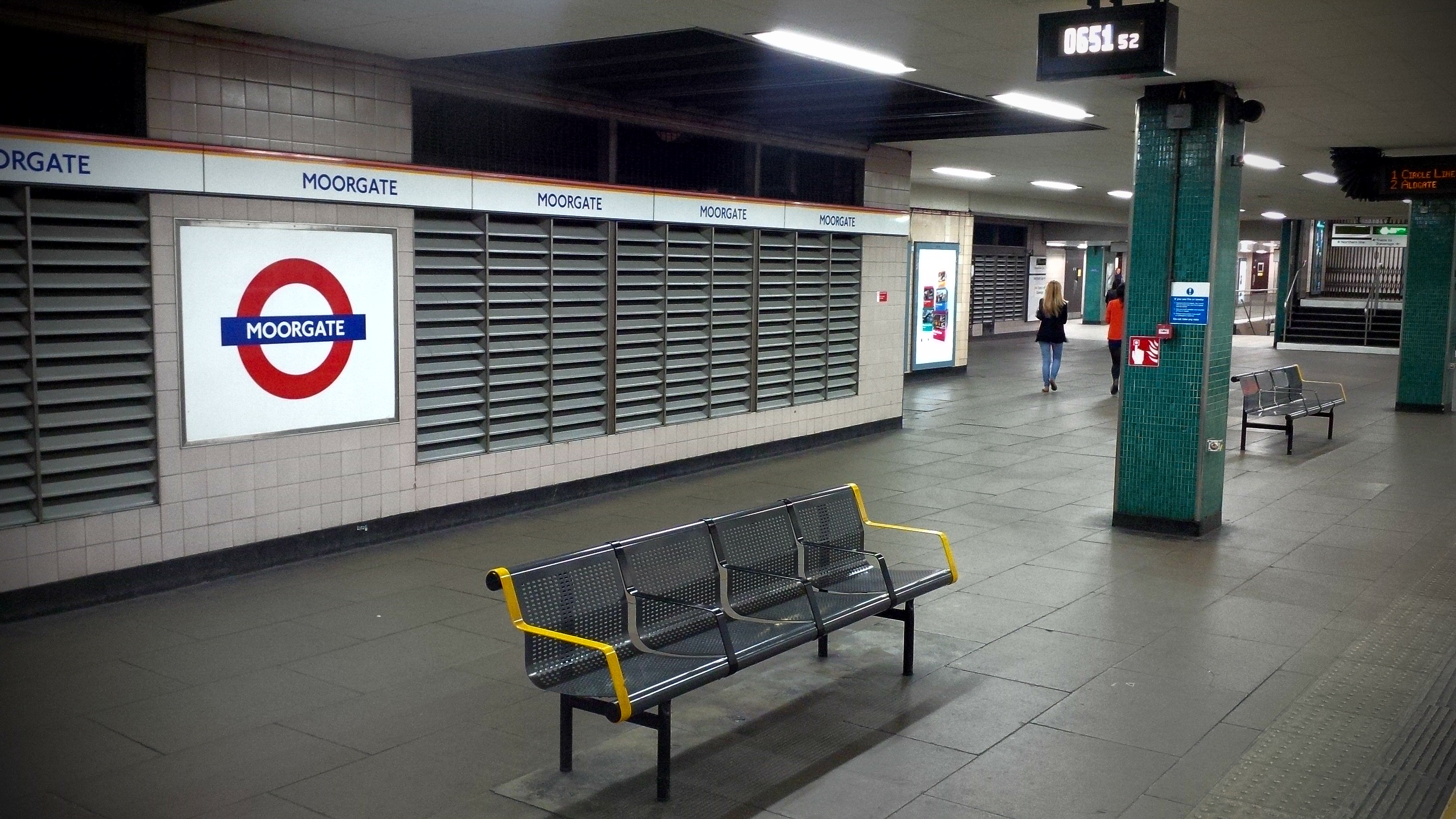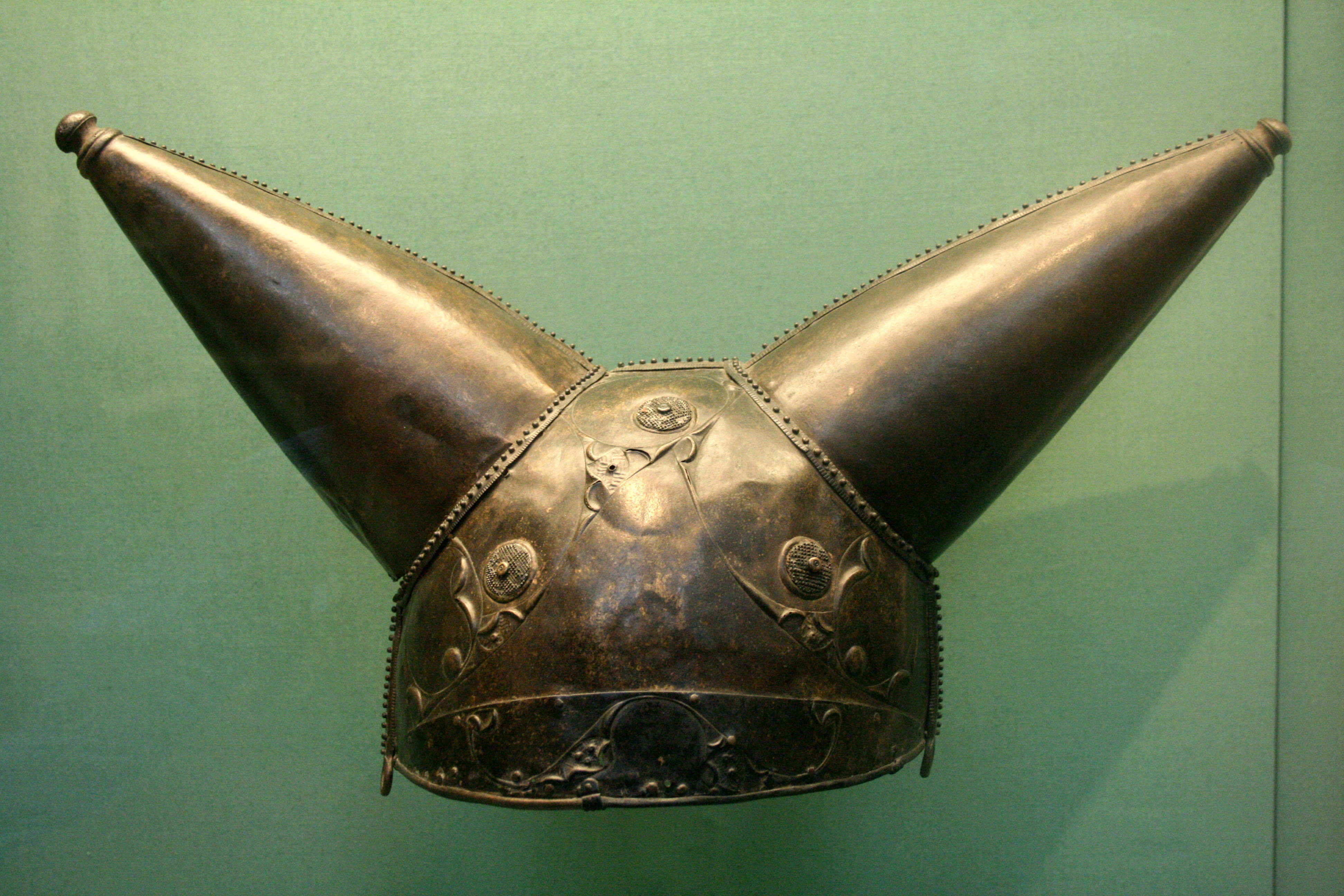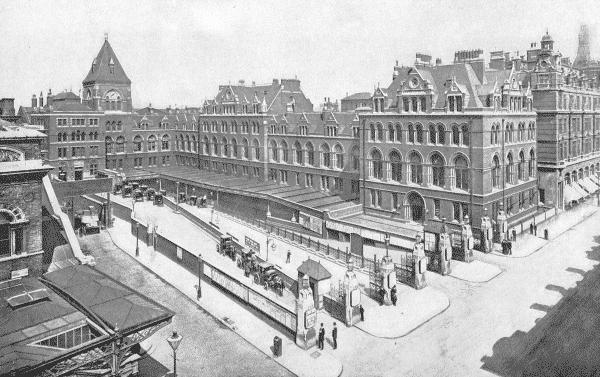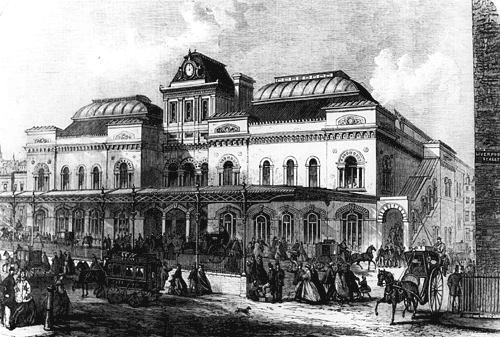|
St James's Park Tube Station
St James's Park is a London Underground station near St James's Park in the City of Westminster, England. It is on the Circle and District lines between Victoria and Westminster stations, and is located in Travelcard Zone 1. The station building is incorporated into 55 Broadway, formerly the headquarters of Transport for London, and has entrances both on the junction of 55 Broadway and Petty France and on Palmer Street, opposite Starbucks. The station is close to several government offices. The station is not wheelchair accessible. St James’s Park is one of two stations serving Buckingham Palace, the other being Green Park. History The station was opened on 24 December 1868 by the District Railway (DR, now the District line) when the company opened the first section of its line between South Kensington and Westminster stations. The DR connected to the Metropolitan Railway (MR, later the Metropolitan line) at South Kensington and, although the two companies were rivals, ... [...More Info...] [...Related Items...] OR: [Wikipedia] [Google] [Baidu] |
London Underground
The London Underground (also known simply as the Underground or as the Tube) is a rapid transit system serving Greater London and some parts of the adjacent home counties of Buckinghamshire, Essex and Hertfordshire in England. The Underground has its origins in the Metropolitan Railway, opening on 10 January 1863 as the world's first underground passenger railway. The Metropolitan is now part of the Circle line (London Underground), Circle, District line, District, Hammersmith & City line, Hammersmith & City and Metropolitan lines. The first line to operate underground electric locomotive, electric traction trains, the City & South London Railway in 1890, is now part of the Northern line. The network has expanded to 11 lines with of track. However, the Underground does not cover most southern parts of Greater London; there are only 33 Underground stations south of the River Thames. The system's List of London Underground stations, 272 stations collectively accommodate up ... [...More Info...] [...Related Items...] OR: [Wikipedia] [Google] [Baidu] |
Earl's Court Tube Station
Earl's Court is a Grade II listed London Underground station in Earl's Court, London, on the District and Piccadilly lines. It is an important interchange for both lines and is situated in both Travelcard Zone 1 and Zone 2. The station has an eastern entrance on Earl's Court Road and a western entrance on Warwick Road (both part of A3220). Another former entrance allowed passengers to enter the station from the other side of Warwick Road, via a ticket hall and subway leading to a concourse beneath the District line platforms. Earl's Court is a step-free tube station; the Earls Court Road entrance provides lift access between street and platform levels. The station was opened by the District Railway in 1871, two years after the line was built, and had become a hub to five different local routes by 1874. It was damaged by fire the following year, and a new station was constructed on the other side of Earl's Court Road, opening in 1878. A connection to the Great Northern, Pi ... [...More Info...] [...Related Items...] OR: [Wikipedia] [Google] [Baidu] |
Hammersmith & City Line
The Hammersmith & City line is a London Underground line that runs between Hammersmith in west London and in east London. Coloured pink on the Tube map, it serves 29 stations over . Between and it skirts the City of London, the capital's financial heart, hence the line's name. Its tunnels are just below the surface and are a similar size to those on British main lines. Most of the track and all stations are shared with the Circle, District or Metropolitan lines. Over 141 million passenger journeys are made each year on the Hammersmith & City line. In 1863, the Metropolitan Railway began the world's first underground railway service between and Farringdon with wooden carriages hauled by steam locomotives. The following year, a railway west from Paddington to Hammersmith was opened and this soon became operated and owned jointly by the Metropolitan and Great Western Railway companies. The line was then extended to the east, in stages, reaching the East London Railway in 1 ... [...More Info...] [...Related Items...] OR: [Wikipedia] [Google] [Baidu] |
Moorgate Station
Moorgate () is a London station group, central London railway terminus and connected London Underground station on Moorgate in the City of London. Main line railway services for Hertford North railway station, Hertford, Welwyn Garden City railway station, Welwyn Garden City and Stevenage railway station, Stevenage are operated by Great Northern route, Great Northern, while the London Underground station is served by the Circle line (London Underground), Circle, Hammersmith & City line, Hammersmith & City, Metropolitan line, Metropolitan and Northern line, Northern lines. The station was opened as Moorgate Street in 1865 by the Metropolitan Railway. In 1900, the City & South London Railway added the station to its network, and the Great Northern & City Railway began serving the station in 1904. In 1975, the Northern City Line platforms were the site of the Moorgate tube crash – at the time, the worst peacetime accident in the history of the London Underground – in which 43 ... [...More Info...] [...Related Items...] OR: [Wikipedia] [Google] [Baidu] |
Middle Circle
The Middle Circle was a Great Western Railway service in London that operated from 1872 to 1905. The route was from the District Railway station at Mansion House to Earl's Court, then via the West London Railway to Latimer Road on to the Hammersmith & City Railway and then via the Metropolitan Railway to the City of London. Although not a complete circuit, it was one of several 'circle' routes around London that opened at the same time, such as the 'inner circle' that is today's Circle line. Trains would run once every 30 minutes. In 1900 the service was cut back to run from Earl's Court to Aldgate, and ended in 1905. History Origins The Great Western Railway (GWR) opened the Hammersmith & City Railway (H&CR) on 13 June 1864, and from 1 July 1864 carriages from Kensington (Addison Road) (now Kensington lympia were attached and detached from trains at Notting Hill; through services between Kensington and the City of London beginning in April 1865. A station had been built o ... [...More Info...] [...Related Items...] OR: [Wikipedia] [Google] [Baidu] |
Mansion House Tube Station
Mansion House is a London Underground station in the City of London which takes its name from Mansion House, the residence of the Lord Mayor of London. It opened in 1871 as the eastern terminus of the Metropolitan District Railway. Today, Mansion House is served by the Circle and District lines. It is between Blackfriars and Cannon Street stations and it is in fare zone 1. The station is located at the junction of Queen Victoria Street and Cannon Street. Mansion House is a sub-surface station with three platforms. The westbound platform, number 1, and the eastbound platform, number 3, are shared by both the Circle and District lines. A third platform was used for terminating eastbound trains, however it is no longer used and the track removed as services continue and terminate at Tower Hill. Despite the station's name, it is not the nearest tube station to Mansion House itself, which is in fact directly opposite an entrance to Bank station. Moreover, two other stations on ... [...More Info...] [...Related Items...] OR: [Wikipedia] [Google] [Baidu] |
Willesden Junction Station
Willesden Junction () is an interchange station located in Harlesden, north-west London. It is situated on the Bakerloo line of the London Underground and the Lioness and Mildmay lines of the London Overground. The station is located close to the Old Oak Lane conservation area in the East Acton ward. History The station developed on three contiguous sites: the West Coast Main Line (WCML) station was opened by the London & North Western Railway on 1 September 1866 to replace the London and Birmingham Railway's Willesden station of 1841 which was to the northwest. Passenger services ended in 1962 when the platforms were removed during the electrification of the WCML to allow the curvature of the tracks to be eased. Later the bridges for the North London line (NLL) were rebuilt. The High-Level station on the NLL was opened by the North London Railway in 1869 for two Richmond tracks and later for two Shepherds Bush tracks, both crossing the WCML roughly at right angles. In ... [...More Info...] [...Related Items...] OR: [Wikipedia] [Google] [Baidu] |
City Of London
The City of London, also known as ''the City'', is a Ceremonial counties of England, ceremonial county and Districts of England, local government district with City status in the United Kingdom, city status in England. It is the Old town, historic centre of London, though it forms only a small part of the larger Greater London metropolis. The City of London had a population of 8,583 at the 2021 United Kingdom census, 2021 census, however over 500,000 people were employed in the area as of 2019. It has an area of , the source of the nickname ''the Square Mile''. The City is a unique local authority area governed by the City of London Corporation, which is led by the Lord Mayor of London, Lord Mayor of the City of London. Together with Canary Wharf and the West End of London, West End, the City of London forms the primary central business district of London, which is one of the leading financial centres of the world. The Bank of England and the London Stock Exchange are both ba ... [...More Info...] [...Related Items...] OR: [Wikipedia] [Google] [Baidu] |
Liverpool Street Station
Liverpool Street station, also known as London Liverpool Street, is a major central London railway terminus and connected London Underground station in the north-eastern corner of the City of London, in the ward of Bishopsgate Without. It is the terminus of the West Anglia Main Line to Cambridge and Ely; the Great Eastern Main Line to Norwich; commuter trains serving east London and destinations in the East of England, including the Weaver line of the London Overground; and the Stansted Express service to Stansted Airport. The station opened in 1874, as a replacement for Bishopsgate station as the Great Eastern Railway's main London terminus. By 1895, it had the most platforms of any London terminal station. During the First World War, an air raid on the station killed 16 on site, and 146 others in nearby areas. In the build-up to the Second World War, the station served as the entry point for thousands of child refugees arriving in London as part of the '' Kindertran ... [...More Info...] [...Related Items...] OR: [Wikipedia] [Google] [Baidu] |
Broad Street Railway Station (London)
Broad Street was a major terminal station, rail terminal in the City of London, adjacent to Liverpool Street station. It served as the main terminus of the North London Railway (NLR) network, running from 1865 to 1986. During its lifetime, it catered for mainly local suburban services around London, and over time struggled to compete with other modes of transport, leading to its closure. The station was built as a joint venture by the NLR and the London and North Western Railway (LNWR) in order to have a station serving freight closer to the City. It was immediately successful for both goods and passenger services, and saw a significant increase in NLR traffic. Usage peaked in the early 20th century, after which it suffered from competition from Trams in London, London trams, buses and, especially, the London Underground network. Patronage gradually fell and services decreased, while the building became increasingly dilapidated. Freight services were withdrawn towards the end o ... [...More Info...] [...Related Items...] OR: [Wikipedia] [Google] [Baidu] |
North London Railway
The North London Railway (NLR) company had lines connecting the northern suburbs of London with the Port of London further east. The main east to west route is now part of London Overground's North London Line. Other NLR lines fell into disuse but were later revived as part of the Docklands Light Railway, and London Overground's East London Line. The company was originally called the East and West India Docks and Birmingham Junction Railway (E&WID&BJR) from its start in 1850, until 1853. In 1909, it entered into an agreement with the London and North Western Railway which introduced common management, and the NLR was taken over completely by the LNWR in 1922. The LNWR itself became part of the LMS from the start of 1923. The railways were nationalised in 1948 and most LMS lines, including the North London route, then came under the control of the London Midland Region of British Railways. History The East and West India Docks and Birmingham Junction Railway was incorporate ... [...More Info...] [...Related Items...] OR: [Wikipedia] [Google] [Baidu] |









